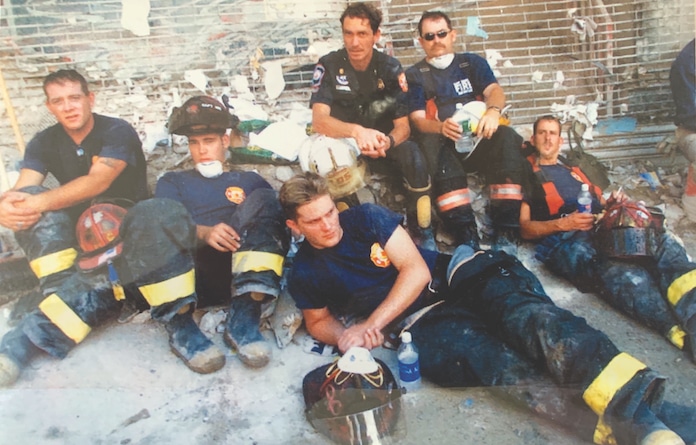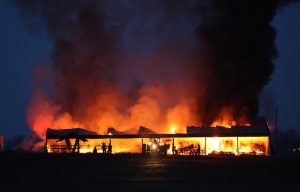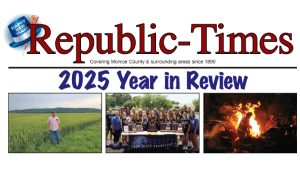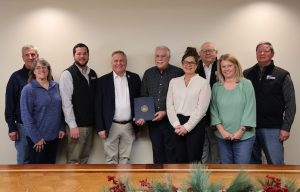Called to serve after 9/11

As the Twin Towers fell, the Pentagon fought flames and United Flight 93 sped into rural Pennsylvania, many across the nation sprung up in ways big and small immediately after the terrorist attacks on Sept. 11, 2001.
Monroe County was no exception. Below are the stories of three Columbia men who used their respective skills to help the grieving nation, two of whom quickly arrived on scene.
Four commercial airliners traveling from the northeastern United States to California were hijacked mid-flight that morning by 19 al-Qaeda terrorists. These attacks resulted in 2,977 fatalities, over 25,000 injuries, and substantial long-term health consequences.
Christopher Fitch
On Sept. 11, 2001, Christopher Fitch was serving as a Cahokia firefighter. Like many across the nation, he watched New York City’s Twin Towers collapse one at a time on TV, but he soon was at the scene.
“We heard that they needed help in New York with recovery efforts, so we had signed up and left the next day,” Fitch said.
With all civilian aircraft being cancelled, Fitch and seven other first responders – a group of Cahokia and Camp Jackson firefighters along with an East Carondelet police officer and his canine – began the 19-hour drive to Ground Zero.
For Fitch, there was no question as to whether or not he should go. He knew he needed to help.
“At the time I was available, and (if) I was available and could help in any way (I would). It’s kind of what we do,” Fitch said. “It was all volunteer. No pay, no nothing. (It was) just to help the community, the fellow firefighters and those who lost their lives.”
Fitch spent approximately three days sifting through rubble, scouring for signs of life alongside other volunteer first responders. He said this solidarity was one of the most impactful parts of his experience.
“The biggest thing was the camaraderie of the City of New York and all the first responders working. Anything we needed – food, water, anything – they took care of it for us. Everybody came together as a big group and supported (one another),” he recalled.
And as he took off his turnout gear each day, he knew the grueling work was appreciated.
“As we left our working day, we had the citizens on the side of the road clapping, thanking (us), giving (us) waters, food, everything. It was a neat experience,” Fitch said.
Fitch now serves as a deputy for the St. Clair Sheriff’s Department.
Andrew Aycock
Andrew Aycock of Columbia was a flight nurse for the 375th aeromedical evacuation squadron in 2001.
It was actually his day off on Sept. 11, 2001 – or it was supposed to be. As he usually did when not at base, he was working at the Forest Park Emergency Department in St. Louis.
“We got notified that a plane hit the building and then everything kind of stopped,” Aycock recalled. “As we were watching things happen, the second plane hit. I can tell you it was less than five minutes before my pager went off … it was one of the charge med techs that I worked with at Scott (Air Force Base) … He said, ‘You need to get home, you need to get back to base and if anybody asks, you were on crew rest since 7 a.m.”
When Aycock was about two miles from base, he noticed it had gone into Delta, or lockdown. Every vehicle was searched and the dogs were on duty, but the charge med tech told Aycock to go around.
Donned in scrubs and a stethoscope around his neck, he reached the squadron where he was told the commander planned on flying as many air evacuation and critical care air transport teams to New York as possible.
By 5:30 p.m., Aycock was in the air serving as the senior medical crew director for his C9 aircraft.
When Aycock and his crew arrived in New York, they were told to stand by in their hotel. As Aycock explained, the AE and CCATTs’ jobs were to transport live patients when hospitals were being overwhelmed with mass injuries. In the case of 9/11, there were not enough live patients for these teams to do their usual jobs.
After a sleepless night in the hotel, Aycock and the rest of his aircraft team members decided it was time to move.
“The next day, we were told to standby and stay in the hotel room. Well, none of us did that. We all basically got together and said ‘We’re going to take it upon ourselves to go down to the Pentagon and help,’” Aycock said. “So, as flyers in uniform, we got into a cab and drove down to the Pentagon and spent that day helping anywhere we could.”
For Aycock, this meant helping firefighters shovel rubble and standing by in case any survivors were found. On the fourth day in Washington, D.C., after the other six aircrafts were called back to Illinois, Aycock and the others on his aircraft stayed to do a ‘morgue move.’
They filled nine body bags with body parts and transported them to the military morgue at Dover Air Force Base, Delaware, for identification.
This, Aycock said, was a flight like no other.
“The one thing that really brought us down was when we got to altitude, and (we were) now in a big tube at 30,000 feet with people who were alive three days ago – or parts of people who were alive,” Aycock said. “(Usually) when we fly, everybody communicates back and forth … Nobody said anything that entire flight … When we arrived, we popped the side ramp open and there were folks from Dover to help us offload and no one said anything. The reality was sitting right in front of us at that point, so everybody was in shock that it happened.”
After returning some CCATTs home in Louisiana, Aycock returned to Scott Air Force Base, but the last five days would stick with him.
Like Fitch, he too was touched by the support he encountered along the way. The night his aircraft arrived in New York, the hotel’s kitchen opened back up especially for the service members, and civilians staying in the hotel bought food for over 50 flight suits.
With news coverage showing the towers’ collapses on repeat, those in the dining area recognized they had formed an instantaneous connection.
“You are now in a room with civilians who you have never met before, but you all have this commonality,” Aycock said of the experience. “Everybody has been impacted by this. It doesn’t matter who you are, if you’re an American, you’ve been impacted by 9/11. It was obvious when we were sitting in that room, we didn’t just sit and talk to the flight suits, everybody was talking.”
Aycock now serves as the division chief for air medical evacuations 618th operation cell at Scott Air Force Base.
Ryan Murray
Unlike Fitch and Aycock, Columbia native Ryan Murray was not directly assisting with 9/11 response efforts. However, that doesn’t mean his future’s trajectory was not shaped by that day.
“I think when you see the Twin Towers fall when you’re 8 years old and you come home, get off the bus and you run inside and your mom is sitting on the floor crying, it makes you want to do something about it,” Murray said.
Over a decade later, Murray earned a law degree from Southern Illinois University Carbondale, and put his education to use as a first lieutenant trial counsel for the 35th MP Brigade, located at Jefferson Barracks.
As Murray simply described his position, he is “the equivalent of the state’s attorney for (his) brigade.”
“The biggest thing is that my role and all soldiers’ role is to serve the army, not necessarily one individual. So we advise the command, but the army is my client,” Murray explained. “We serve the army as a whole and make sure all of the legal things are being taken care of correctly for the army.”
Even though he was a child on Sept. 11, 2001, Murray said he has heard countless service members testify that from discounts to simple ‘thank yous,’ the country as a whole has shown greater appreciation toward them in the wake of 9/11.
To him, his role in the Army is a way to give back. He said it’s “hard to divorce” his decision to join the army from the increase in patriotism resulting from the events of 9/11.
“I joined (the Army) to serve and give back … and that was the culture that I grew up in, that was the post-9/11 culture of America,” Murray said. “I just think when you have the ability to serve and you have the ability to help people, you have a responsibility to help people. That’s why I chose to serve.”






